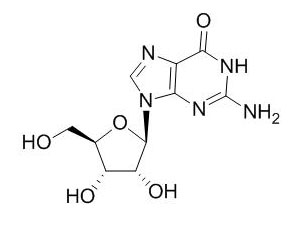Guanosine
Guanosine and GMP show anticonvulsant properties, which may be related with antagonism of glutamate receptors; they also prevent seizures induced by quinolinic acid in mice.Guanosine protects against renal ischemic injury by replenishing GTP stores and preventing tubular apoptosis.
Inquire / Order:
manager@chemfaces.com
Technical Inquiries:
service@chemfaces.com
Tel:
+86-27-84237783
Fax:
+86-27-84254680
Address:
1 Building, No. 83, CheCheng Rd., Wuhan Economic and Technological Development Zone, Wuhan, Hubei 430056, PRC
Providing storage is as stated on the product vial and the vial is kept tightly sealed, the product can be stored for up to
24 months(2-8C).
Wherever possible, you should prepare and use solutions on the same day. However, if you need to make up stock solutions in advance, we recommend that you store the solution as aliquots in tightly sealed vials at -20C. Generally, these will be useable for up to two weeks. Before use, and prior to opening the vial we recommend that you allow your product to equilibrate to room temperature for at least 1 hour.
Need more advice on solubility, usage and handling? Please email to: service@chemfaces.com
The packaging of the product may have turned upside down during transportation, resulting in the natural compounds adhering to the neck or cap of the vial. take the vial out of its packaging and gently shake to let the compounds fall to the bottom of the vial. for liquid products, centrifuge at 200-500 RPM to gather the liquid at the bottom of the vial. try to avoid loss or contamination during handling.
Phytomedicine.2018, 41:62-66
Nat Commun.2023, 14(1):5075.
Eur Rev Med Pharmacol Sci.2020, 24(9):5127-5139.
J Pharm Biomed Anal.2024, 251:116444.
Phytomedicine.2019, 65:153089
Plants (Basel).2021, 10(7):1376.
J Agric Food Chem.2020, 68(51):15164-15175
Evid Based Complement Alternat Med.2021, 2021:8847358.
Drug Chem Toxicol.2024, 1-10.
Plant Cell Tiss Org2020, 1-16
Related and Featured Products
Brain Res. 2000 May 2;864(1):40-3.
Guanosine and GMP prevent seizures induced by quinolinic acid in mice.[Pubmed:
10793184]
In the mammalian CNS, glutamate and GABA are the principal neurotransmitters mediating excitatory and inhibitory synaptic events, respectively, and have been implicated in the neurobiology of seizures. Guanine-based purines, including the nucleoside Guanosine and the nucleotide GMP, have been shown to antagonize glutamatergic activity at the receptor level and the other purine nucleoside adenosine is a well-known modulator of seizure threshold.
CONCLUSIONS:
In the present study we investigated the anticonvulsant effect of i. p. Guanosine and GMP against seizures induced by the glutamate agonist quinolinic acid (QA) or the GABA(A) antagonist picrotoxin in mice. Animals were pretreated with an i.p. injection of saline, Guanosine or GMP 30 min before either an i.c.v. injection of 4 microliter QA (36.8 nmol) or a subcutaneous injection of picrotoxin (3.2 mg/kg). All animals pretreated with vehicle followed by QA or picrotoxin presented seizures, which were completely prevented by the NMDA antagonist MK-801 and the GABA agonist phenobarbital, respectively. Guanosine and GMP dose-dependently protected against QA-induced seizures, up to 70 and 80% at 7.5 mg/kg, with ED(50)=2. 6+/-0.4 and 1.7+/-0.6 mg/kg, respectively. Conversely, neither Guanosine, GMP nor MK-801 affected picrotoxin-induced seizures, indicating some degree of specificity towards the glutamatergic system.
CONCLUSIONS:
This study suggests anticonvulsant properties of i.p. Guanosine and GMP, which may be related with antagonism of glutamate receptors.
J Clin Invest. 2001 Nov;108(9):1291-8.
Guanosine supplementation reduces apoptosis and protects renal function in the setting of ischemic injury.[Pubmed:
11696573 ]
Ischemic injury to the kidney is characterized in part by nucleotide depletion and tubular cell death in the form of necrosis or apoptosis. Recently, we linked anoxia-induced apoptosis in renal cell cultures specifically to the depletion of GTP. We therefore hypothesized that enhancing GTP repletion in vivo might protect function by reducing apoptosis in postischemic tubules.
METHODS AND RESULTS:
Male C57 black mice (the "I" group of animals) underwent bilateral renal artery clamp for 32 minutes to induce ischemia and then received either normal saline ("NS") or Guanosine ("G"). After 1 hour of reperfusion, renal GTP levels in NS/I were reduced to nearly half of those in sham operated mice, whereas these levels were nearly unchanged in G/I mice. Morphologic examination of tubular injury revealed no significant differences between the two groups. However, there was a significant reduction in the number of apoptotic tubular cells in the medulla in the G/I group as compared with the NS/I group. At 24 hours, creatinine was significantly elevated in the NS/I group, compared to the G/I group.
CONCLUSIONS:
We conclude that Guanosine protects against renal ischemic injury by replenishing GTP stores and preventing tubular apoptosis.



